Soldier beetle
| Soldier beetle |
|---|

|
| Scientific Classification |
|
| Genera |
|
Soldier beetle is the common name for any of the species belonging to the taxonomic Family Cantharidae.[1] It consists of a variety of colors and can be found in your everyday garden feeding on a variety of smaller insects. [2] The abdomen, thorax, and head are the three main parts of its body. [3] It has six, segmented legs. Soldier beetles are sexual and mate in their fourth stage of life. [4]
Anatomy
The soldier beetle can grow from three to eighteen millimeters long. Cantharidae's sense of smell comes from their antennae at the top of their heads. Mating and feeling are also good uses for them. [5] Its exoskeleton on its back splits into two sections. They are usually bright red and black.[6][7] The soft, flat body of the beetle is a little different from its larvae. [8] The body of the larvae is also flat. Its head is distinct along with its long legs and tail that splits into two. The entire body is usually covered in little fine hairs and is dark. [9] The three sections of a soldier beetle's body are the head, thorax, and abdomen.[10]
The head of the beetle contains a few major body parts. First off, it has jointed antenna.[11] It also has mouthparts including mandibles, maxillary palp, and labial palp.[12] But one of the most distinct parts of insects are their eyes. A soldier beetle has a compound eye, which means they have multiple lenses that allow them to see from many angles at once. [13]
The legs and wings are attached to the thorax. The thorax is located in between the head and the abdomen. The end of the beetle is segmented; this is the abdomen. The abdomen is vital to the beetle, because it contains all the important organs like the heart, the majority of the digestive system, and reproductive organs. [14]
Reproduction
There are four stages of the Soldier Beetle's life. First is egg. The mother soldier beetle takes her eggs and puts them in a place of protection, as in under a leaf. When the egg hatches it becomes larvae. This stage makes the beetle look like a very tiny worm. [15] The larvae eats mainly leaves, but if the opportunity comes it will eat other insects if they are smaller. [16] Once it eats enough it grows into a pupa (the next stage in life). The pupa looks like a small slimy beetle. [17] This is right before the final stage, which is an adult. As an adult the females and males mate, it's also called pairing. The female's egg is fertilized when she receives sperm cells from the male. [18]
Ecology
The soldier beetle is a carnivore. Its diet depends on its environment. In the lawn it will eat white cut worms. In the yard and garden the Cantharidae eats aphids, spider mites, small caterpillars, grasshopper eggs, moth larvae, and fall webworms. Trees provide gypsy moth caterpillars, eastern tent caterpillars, codling moths, birch leafminers, elm leaf beetles, oak webworms, and lilac leafminers. Finally, in the vegetable garden it eats cucumber beetles, aphids, Mexican bean beetles, cabbage loopers , imported cabbage worms, corn earworms, Colorado potato beetles, asparagus beetles, eggplant lace bugs, and onion maggots. These are only some examples of its dietary habits, it has too wide of a variety to include them all. [19]
The soldier beetle lives in British Columbia, Quebec, Eurasia, and now North America. It usually lives in fields. It also lives in hedgerows and meadows. During the day, when its light outside the adults like to frolic on the flowers and herbaceous plants. The adults live during the months of June and July, but that may vary a little depending on the country. [20] The larvae can be found on moist ground or under small objects such as bark. They like to eat small insects, but some species are unique in that they devour crops such as grains, potatoes, and celery. [21]
Color
The color of soldier beetles is very unique because it varies depending on the species. The color of the egg is white, the larvae is either black, red, or brown. The pupa is generally yellow. Some adult beetles are yellow, orange, brown, red, and sometimes black. They usually have spots, but can also be a solid color. Their color does not have anything to do with their surroundings or predators, like some other organisms do. Their color is clearly for show and helps in identifying them. [22]
Gallery
 Browse |
References
- Cantharidae: Soldier beetles by Encyclopedia of Life.
- Soldier Beetle Identification Identification.org, Runway Studios, 2005-2010.
- Soldier Beetle Reproduction Encyclopedia II, Wikipedia.
- Soldier Beetle Anatomy Animal Corner, 2003-2010.
- Soldier Beetle Body OzAnimals.
- Soldier Beetle New World Encyclopedia, August 29, 2008.
- Soldier Beetle Structure David Kendall, Kendall Bioresearch, January 2009.
- Soldier Beetle Behavior and Reproduction unknown.
- Soldier Beetle's Diet Wanttoknowit.
- Soldier Beetle Pupa Iowa State University, Bugguide, 2003-2010.
- Soldier Beetle Ecology Yardener.
- Red Soldier Beetle Iowa State University, Bugguide, 2003-2010.






